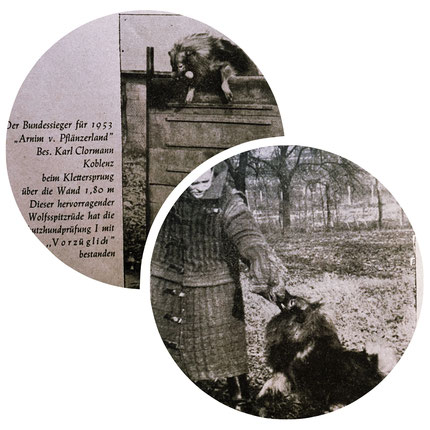An ode to the Wolfspitz

They come from Westphalia, the Wolfspitzes - also called "Fuhrmannsspitze" (coachman's Spitzes)- which have no resemblance to their cousin, the wolf. They are faithful companions of man, but are reluctant to flatter and ingratiate themselves; They appear serious, almost gloomy in their facial expressions and in their sullen manner. They don't like lying around lazily, they are always busy, extreme vigilance is what drives them. A strong set of teeth makes it seem pointless to get to know them. From the thick lion's mane-like ruff around the neck - as protection against bites from combative conspecifics and cousins - the suspicious-looking, smooth face always looks out with the short, upright ears. The medium-sized, square body is protected by a coat of hair so thick that neither annoying heat nor bitter cold, nor rain nor snow, can reach the bottom of the skin.
They are tough fellows, our good old Wolfspitzes and like no other breed they are predestined as farm and guard dogs - also because they also have herding instincts and driving dog qualities and can even drive herds of cattle completely independently. Therefore, as before, they deserve to be kept again by farmers as non-poaching guard dogs. From my own observation and from the reports of other Wolfspitz owners, I can only say that it seems almost striking when our Wolfspitzes stand at the wide open yard or garden gate, as if there was an invisible wall in front of them. Hares can hop close by, deer can pass by - the Wolfspitz pays no attention to them.
Our Wolfsspitzes were also always the loyal and reliable guards of the carters, who guarded the belongings on the wagon, who did not care about the game that stood to the left and right of the path, changing or feeding familiarly. For these guard dogs there was to be no hunting pleasure: their area was the wagon with its often valuable load, between whose high rear wheels they ran obediently and without a leash.

In the past, when the roads in the country were still lined with large dunghills, these formed a wonderful perch for the Wolfsspitzes, from which they could have a particularly good view of the area in front of the farm and the entrances. Anyone who went quietly on their way was left unmolested, but anyone who stopped or behaved conspicuously had to expect to be attacked.
But they are also really amazing dogs, our Wolfspitzes: They don't bark unnecessarily, they only make noise when necessary and can then be easily told to calm down. They are as smart as a fox, understand every human word, know how to judge everyone according to their character and adore the children of the family. Their wisdom and their empathy for people is always astonishing! And then the facial expression! Looking directly into your soul. 🖤
Wolfsspitzes have a very original nature, love a lot of freedom - they hate coercion - and are extremely close to nature. Many wolves enjoy being outside in the snow, even in winter, while other dog breeds have long since retreated into their homes.
They, our Wolfspitzes, were extremely popular protection dogs, which not only had police approval, but were even requested by the Bundeswehr in 1971. But also Wolfsspitzes who “only” completed the classic protection dog training often performed above average, such as the Wolfsspitz male “Arnim vom Pflänzerland”, national winner in 1953.

Unfortunately, those days are over. More and more often you see so-called Wolfspitzes, which are barely larger than a Mittelspitz and can only see out of their mounds of fur with difficulty. It annoys me that our long-lived and robust Wolfsspitz is degenerating more and more into a lapdog. The Wolfspitz is a very old German dog breed - not Dutch, not English or whatever other old wives' tales are floating around in the air - which is why Germany keeps the studbook and sets the standard for Wolfsspitz both at home and abroad. So what exactly happened that our dog breed was not simply deprived of its name abroad ("Keeshond"), but that we in Germany are increasingly orienting ourselves towards what is considered the breeding goal for the Wolfsspitz abroad - or for that, what is meant by that there? Conversely, it would be right: foreign countries should please conform to our standards!
We lovers of the German Wolfspitz should therefore all strive to combine the useful with the beautiful: to return this noble, ancient breed to its original task of being the guardian of house and yard, without neglecting the breeding for shape and coat (or to exaggerate!). The Wolfspitzes have to go back to the farms - in their original form so that they are able to work: i.e. big, with adequate and harsh fur and the right sharpness. Just as the hunter doesn't hunt with a Shih Tzu or a Chihuahua, but with a real hunting dog, only those dog breeds that are born guards belong in guard duty - and these were and are our German Spitzes.




